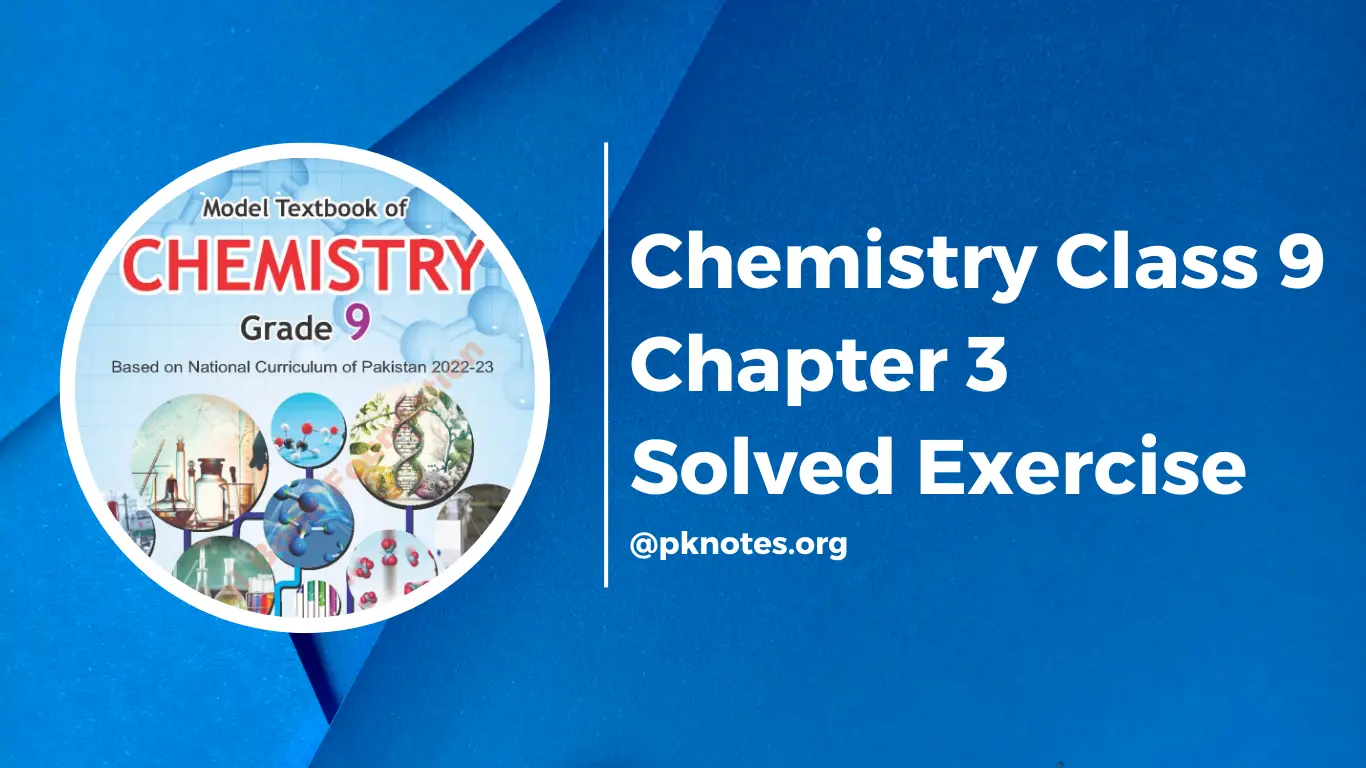At pknotes.org, we have provided you with Class 9 Chemistry Chapter 3 Notes Solved Exercise which are according to the curriculum provided by FBISE (Federal Board of Intermediate and Secondary Education), these notes are from the grade 9 chemistry of National Book Foundation. Visit our YouTube Channel for more video lectures.
Atomic Structure
Solved Exercise
Get PDF NotesChemistry Class 9 Chapter 3 Short Question Answers
(i) Distinguish between shell and sub-shell.
-
- Shell: The electron in an atom revolves around the nucleus in one of the circular orbits, labelled as K, L, M, N, etc.
-
- Sub-shell: A sub-shell is a division within a shell where electrons with specific energy are located. Sub-shells are labelled as s, p, d, f. s sub-shell can hold up to 2 electrons, p sub-shell can hold up to 6 electrons, d sub-shell can hold up to 10 electrons, f sub-shell can hold up to 14 electrons.
(ii) Why is an atom electrically neutral?
An atom is electrically neutral because the number of protons (positive charges) is equal to the number of electrons (negative charges). The opposite charges balance each other, resulting in no overall charge.
(iii) How many sub-shells are there in the N shell?
The N shell corresponds to the 4th energy level, and it contains 4 sub-shells. These sub-shells are: s, p, d, and f.
(iv) Give notation for sub-shells of M shell.
The M shell is the 3rd energy level, and its sub-shells are:
-
- 3s
-
- 3p
-
- 3d
(v) List the sub-shells of M shell in order of increasing energy.
The sub-shells of the M shell in order of increasing energy are:
-
- 3s
-
- 3p
-
- 3d
(vi) Can you identify an atom without knowing the number of neutrons in it?
Yes, an atom can be identified without knowing the number of neutrons. The identity of an atom depends on the number of protons, which is its atomic number. The number of neutrons only helps to determine the isotope of the element, not the element itself.
The electronic configurations listed are incorrect. Explain what mistake has been made in each and write correct electronic configurations.
-
- x = 1s², 2s², 2p⁶, 3p²
-
- Mistake: The electron should fill the 3s orbital before 3p.
-
- Correct configuration: 1s², 2s², 2p⁶, 3s².
-
- x = 1s², 2s², 2p⁶, 3p²
-
- y = 1s², 2s¹, 2p¹
-
- Mistake: 2s should be completely filled before 2p.
-
- Correct configuration: 1s², 2s².
-
- y = 1s², 2s¹, 2p¹
-
- z = 1s², 2s², 2p⁵, 3s¹
-
- Mistake: The 2p sub-shell should be completely filled before moving to 3s.
-
- Correct configuration: 1s², 2s², 2p⁶.
-
- z = 1s², 2s², 2p⁵, 3s¹
4. Which orbital in each of the following pairs is lower in energy?
-
- (a) 2s, 2p:
Answer: 2s has lower energy than 2p.
- (a) 2s, 2p:
-
- (b) 3p, 2p:
Answer: 2p has lower energy than 3p.
- (b) 3p, 2p:
-
- (c) 3s, 4s:
Answer: 3s has lower energy than 4s.
- (c) 3s, 4s:
5. Draw Bohr’s Model for the following atoms indicating the location for electron, protons, and neutrons:
-
- (a) Potassium (Atomic No. 19, Mass No. 39)
-
- Protons: 19
-
- Neutrons: 20
-
- Electrons: 19
(Bohr model: 2 electrons in the first shell, 8 in the second, 8 in the third, and 1 in the fourth shell.)
- Electrons: 19
-
- (a) Potassium (Atomic No. 19, Mass No. 39)
-
- (b) Silicon (Atomic No. 14, Mass No. 28)
-
- Protons: 14
-
- Neutrons: 14
-
- Electrons: 14
(Bohr model: 2 electrons in the first shell, 8 in the second, and 4 in the third shell.)
- Electrons: 14
-
- (b) Silicon (Atomic No. 14, Mass No. 28)
-
- (c) Argon (Atomic No. 18, Mass No. 39)
-
- Protons: 18
-
- Neutrons: 21
-
- Electrons: 18
(Bohr model: 2 electrons in the first shell, 8 in the second, and 8 in the third shell.)
- Electrons: 18
-
- (c) Argon (Atomic No. 18, Mass No. 39)
6. Write electronic configuration for the following elements:
-
- (a) ²⁸₁₄Si:
Electronic configuration: 1s², 2s², 2p⁶, 3s², 3p².
- (a) ²⁸₁₄Si:
-
- (b) ²⁴₁₂Mg:
Electronic configuration: 1s², 2s², 2p⁶, 3s².
- (b) ²⁴₁₂Mg:
-
- (c) ²⁷₁₃Al:
Electronic configuration: 1s², 2s², 2p⁶, 3s², 3p¹.
- (c) ²⁷₁₃Al:
-
- (d) ⁴⁰₁₈Ar:
Electronic configuration: 1s², 2s², 2p⁶, 3s², 3p⁶.
- (d) ⁴⁰₁₈Ar:
7. State the importance and uses of isotopes in various fields of life.
-
- Medicine: Isotopes like Iodine-131 are used in the diagnosis and treatment of thyroid disorders.
-
- Archaeology: Carbon-14 is used in radiocarbon dating to determine the age of ancient objects.
-
- Agriculture: Radioactive isotopes help in studying plant metabolism and improving crop varieties.
-
- Industry: Isotopes like Cobalt-60 are used for checking material defects and sterilizing medical equipment.
8. The atomic number of an element is 23 and its mass number is 56.
-
- (a) How many protons and electrons does an atom of this element have?
Answer: The element has 23 protons and 23 electrons.
- (a) How many protons and electrons does an atom of this element have?
-
- (b) How many neutrons does this atom have?
Answer: Neutrons = Mass number – Atomic number = 56 – 23 = 33 neutrons.
- (b) How many neutrons does this atom have?
9. The atomic symbol of aluminum is written as ²⁷₁₃Al. What information do you get from it?
-
- Answer:
-
- The atomic number (13) tells us aluminum has 13 protons and 13 electrons.
-
- The mass number (27) tells us aluminum has 27 – 13 = 14 neutrons.
-
- Answer:
